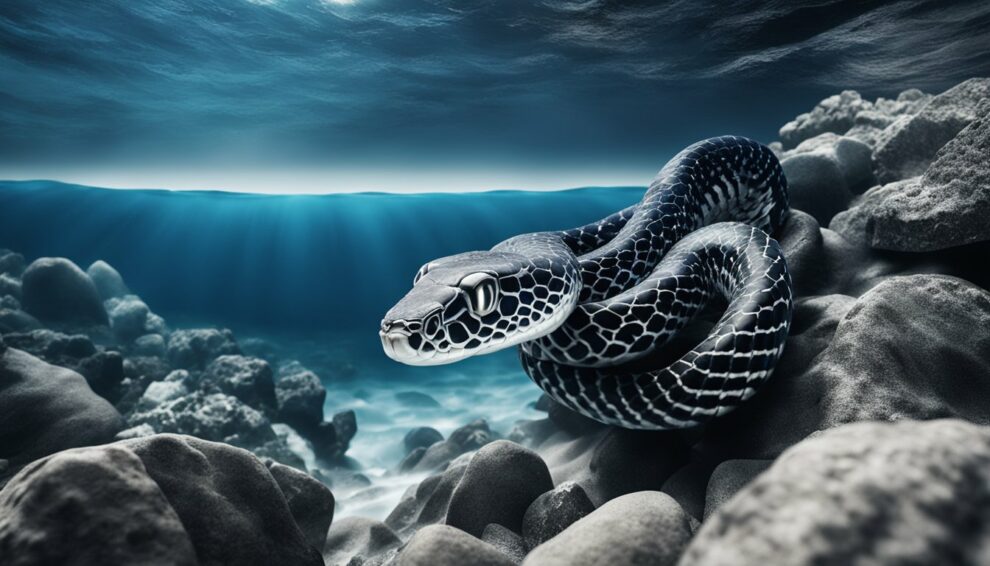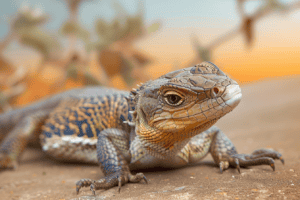Sea Kraits lead a remarkable dual existence between land and sea, displaying unique adaptations that allow them to thrive in two contrasting environments.
These slender serpents spend the majority of their marine lives hunting in the coral reefs and coming up for air every few hours.
While they display proficiency in their aquatic endeavors, they are equally adept on land, where they bask, digest their food, lay their eggs, and sometimes slumber away from water.

Have you ever pondered how a creature can be so versatile to call both the shore and the surf its home? It’s all about balance for these reptiles.
Their paddle-shaped tails act as powerful propellers underwater, while their scales provide grip during terrestrial sojourns.
With this dual lifestyle, sea kraits consume a diet rich in eels and small fish, seizing them with a potent venom that is among the strongest of any sea snake species.
But why exactly do these serpents shuffle between land and sea? It’s a question of survival and biology.
Sea kraits lay their eggs on land, where they are safe from aquatic predators, giving their hatchlings a better chance at life.
Their land visits also serve to eliminate salt accumulated from swimming in the ocean.
Indeed, every move they make is a testament to the incredible adaptability of sea kraits, living comfortably in two worlds that seem as different as night and day.
Distinctive Features of Sea Kraits

Sea Kraits are unique reptiles that have mastered life both in the ocean and on land.
Their distinct characteristics allow them to thrive in two very different environments, presenting a remarkable case of adaptation.
Amphibious Lifestyle
Sea Kraits split their time between land and water, an impressive juggling act in the animal kingdom.
Some species, like the Laticauda colubrina, spend up to half of their time on land, frolicking amongst the rocks or resting in coastal caves.
When on land, they lay eggs, digest food, and even shed their skin.
What might it feel like to be equally at home on the sandy beach and in the rolling waves?
Physical Adaptations
The physical characteristics of Sea Kraits make them adept at both swimming and slithering.
They possess a paddle-shaped tail for expert navigation through the bustling coral reefs and an elongated, laterally compressed body ideal for swift underwater movements.
Have you ever seen a snake-shaped fish? That’s not too far off from what a Sea Krait looks like when it glides through the water!
With scales that grip and muscles that contract, these creatures can climb trees and rocks with the same ease as they cruise the sea.
Their dual life requires a fine balance – lungs for breathing air and skin that can absorb small amounts of oxygen underwater.
Can you imagine holding your breath while chasing after fish? Sea Kraits can stay submerged for hours before resurfacing for a gulp of fresh air!
With specialized salt-excreting glands and a diet made mainly of eel, they harness the best of both worlds.
They can move through their two realms with the confidence of a creature designed for diversity.
Habitat and Distribution
Sea kraits, with their distinctive land-and-sea lifestyle, thrive in regions where they can easily transition between their aquatic and terrestrial habitats.
Intriguingly, they choose specific environments that cater to all their living requirements.

Coastal Regions
On the edge of land and sea, these slithery residents find ideal conditions where the water meets the land.
Coastal areas in the tropical Indo-Pacific region serve as the primary habitat for sea kraits.
In these areas, you can find them basking on warm, sunlit beaches or skimming through shallow waters.
For example, the banded sea krait (Laticauda colubrina), prefers coastal waters around coral reefs and mangroves, which provide plenty of food and shelter.
These regions support a rich diversity of sea kraits, where their presence is not only a sign of a healthy ecosystem but also an enchanting sight for beachgoers.
Island Environments
They are also quite at home in island environments.
Their presence is noticeable in the coastal zones of islands throughout Southeast Asia, extending from the Ryukyu Islands of Japan down through the Philippine archipelago to the oceanic vistas of Fiji and New Caledonia.
Islands offer a unique setting with secluded coves and abundant marine life, creating a paradise for sea kraits to hunt and rest.
Here, one could stumble upon a sea krait while they are laying eggs in the island’s sandy recesses or while taking a respite in coastal caves.
Sea kraits’ island utilization highlights their adaptability and the varied ways these environments can fulfill their life cycle needs.
Diet and Hunting Techniques

Sea kraits have evolved unusual adaptations that enable them to thrive both in the aquatic and terrestrial environments.
Their diet mainly consists of eels and small fish, which they hunt using specialized techniques.
Prey and Predation
Sea kraits predominantly feed on moray eels and other eel-like fish.
These slithery meals are often found hiding in coral reefs or rock crevices underwater.
Can you imagine having your favorite snack tucked away in a sea fortress? That’s what it’s like for these snakes!
They have to navigate the labyrinth of coral to find their food.
Sea kraits have developed a strong venom that immobilizes their prey upon injection, making it easier for them to consume their often larger and very muscular meals despite their own slender bodies.
Feeding Strategies
When a sea krait detects a potential meal with its forked tongue, the hunt begins.
Unlike many other snake species that rely on constriction, sea kraits employ their venom to subdue their prey. They elegantly slither through complex coral formations, using their paddle-shaped tails to swim, demonstrating remarkable agility both on land and underwater.
Did you know that they don’t actually need to eat very often? They can go for weeks or even months between meals due to their slow metabolism.
This low-energy lifestyle is particularly well-suited to their amphibious way of life, allowing them to spend ample time both soaking up the sun on land and diving for dinners in the sea.
Reproduction and Life Cycle

Sea kraits have a unique approach to their reproduction and life cycle, starting with their mating rituals on land and leading into the fascinating development of their offspring.
Mating Habits
Sea kraits are distinctive in their mating practices. When it’s time to reproduce, these reptiles slither out of the water and onto land.
They do so because it is safer from marine predators, and it helps them conserve energy during the strenuous mating process.
Females release a scent that attracts males, often leading to a gathering termed a “mating ball,” where multiple males vie to pair with a single female.
This enthusiastic event occurs annually, typically in warm seasons when conditions are optimal.
Development of Offspring
After a successful mating, female sea kraits lay their eggs on land, often in hidden nests or crevices, which vary in numbers but can be around half a dozen.
These protected spaces shelter the eggs from predators and environmental extremes.
It takes several months for the eggs to hatch, and during this time, the embryos grow inside, based on yolk for sustenance.
When the offspring finally emerge, they are miniature versions of adults, fully equipped with venom and swimming capabilities, ready to slither into the sea.
It’s intriguing to note that they receive no parental care and must survive on their own from the moment they hatch.
Frequently Asked Questions

Sea kraits have unique habits that spark curiosity. Here are answers to some of the most common queries about these remarkable reptiles.
What determines the deadly impact of banded sea krait venom?
The lethal power of a banded sea krait’s venom is due to the potency of its neurotoxins.
These substances interrupt communication between the nervous system and muscles, potentially causing paralysis.
The actual impact depends on the amount of venom injected and the sensitivity of the victim to these toxins.
How does a sea krait’s bite differ from that of other sea snakes?
While both sea kraits and other sea snakes possess venom, sea kraits tend to be less aggressive and rarely bite humans.
Their fangs are also shorter than those of other sea snakes, and they inject less venom per bite, which typically results in fewer human envenomations.
In what ways can you distinguish different species of sea kraits?
Different species of sea kraits can be identified by their distinct color patterns and scales.
For instance, one can spot the blue-lipped sea krait by its black body with narrow white bands and, of course, its prominent blue lips.
Each species has its unique look that sets it apart.
What’s the maximum size sea kraits can grow to?
Sea kraits can impress with their size. The largest species, the yellow-lipped sea krait, can grow up to 2.5 meters in length!
This is quite large when considering the average size of other sea kraits, which typically ranges from 1 to 1.5 meters.
How do sea kraits adapt to life on both land and in water?
Sea kraits are equipped with special adaptations for their dual lives.
Their paddle-shaped tails help them glide through the water with ease, while the ability to close their nostrils keeps water out when submerged.
On land, their muscular bodies allow them to move with surprising agility.
Where in the world can you typically find sea kraits?
Sea kraits are mainly spread across the warm coastal waters of the Pacific and Indian oceans, from the east coast of Africa to the islands of the Pacific.
One could encounter these serpents on the shores of Southeast Asia, New Guinea, and many Pacific archipelagos.









